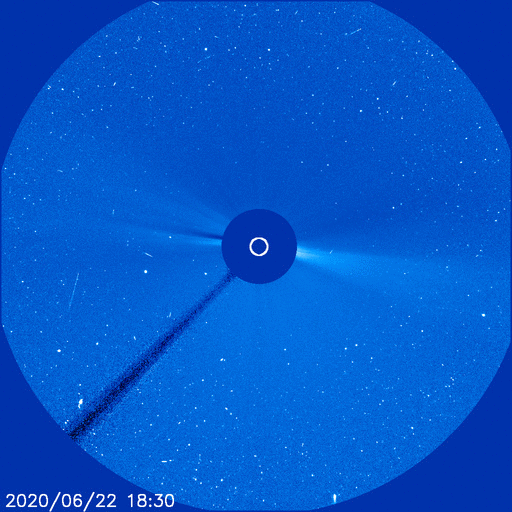11:15 AM | *A comet may…just may…be visible in mid-July*
Paul Dorian
Two-day imagery loop of Comet NEOWISE (lower, right) as recorded by the NASA SOHO “C3” coronagraph (courtesy NASA, spaceweather.com)
Overview
As Yogi Berra would say…”its déjà vu all over again”. First, there was Comet ATLAS in April which broke apart into pieces. Then there was Comet SWAN in May which also disintegrated. And now we have a third opportunity for a visible comet as NEOWISE is creating some hope as it plunges towards the sun. In fact, in the last couple of days, Comet NEOWISE has nearly tripled in brightness raising expectations for an unaided eye view when it emerges from the sun’s glare in mid-July.
Comet NEOWISE displays a bright head and faint tail on June 10, 2020. The comet will reach perihelion (closest to the sun) on July 3 and swing closest to the Earth on July 23 at 64 million miles. (Courtesy Duluth News Tribune, MIchael Mattiazzo)
Discussion
Images from NASA’s Solar and Heliospheric Observatory (SOHO) indicated Comet NEOWISE (officially known as C/2020 F3) has actually nearly tripled in brightness in just the past couple of days as it plunges towards the sun. This comet which is named for the NASA spacecraft mission (Near-Earth Object Wide-field Infrared Survey Explorer) which discovered it back in March is currently rounding the sun and will pass nearest to it on Friday, July 3rd at a distance of 27.3 million miles, nearly 9 million miles closer than Mercury. If it survives the solar onslaught – and that is always a big IF – then sky watchers in the Northern Hemisphere will see the comet peep over the northeastern horizon at dawn starting around July 7th.
Use the star Capella in Auriga to guide you to the comet. The tail orientation and length is only a rough guess. Be sure you’re out in a dark sky just before dawn to anticipate the comet. From many locations dawn starts about two hours before sunrise. (Courtesy Bob King, writer for the Duluth News Tribune)
In recent days, NASA’s SOHO has been closely monitoring Comet NEOWISE with its two coronagraphs onboard, one has a 3-degree field-of-view and the other a 16-degree field-of-view. A coronagraph is a telescope that is used to see objects close to the sun and it uses a disk to block out the sun’s bright surface. In other words, a coronagraph produces an artificial solar eclipse. This process can lead to the revelation of faint solar corona, stars, planets and sun grazing comets. In the last couple of days, Comet NEOWISE has rapidly brightened since it entered the coronagraph’s field-of-view on June 23rd according to spaceweather.com. In fact, it has jumped from magnitude +4.0 to +2.9 in just the past couple of days. If this trend continues, Comet NEOWISE would likely be quite easy to see with the unaided eye when it emerges from the sun’s glare by the middle of next week.
Stay tuned and hope that the third time is a charm.
Meteorologist Paul Dorian
Perspecta, Inc.
perspectaweather.com
Follow us on Facebook, Twitter, YouTube



